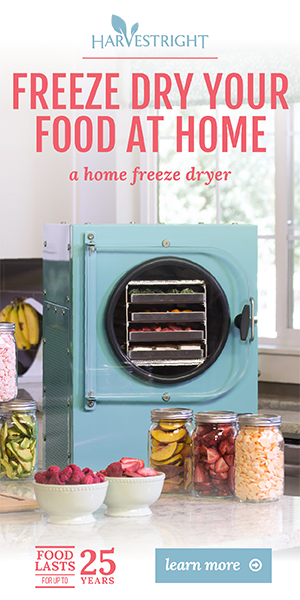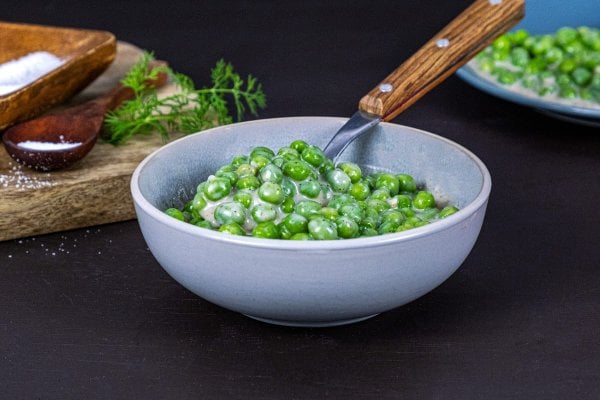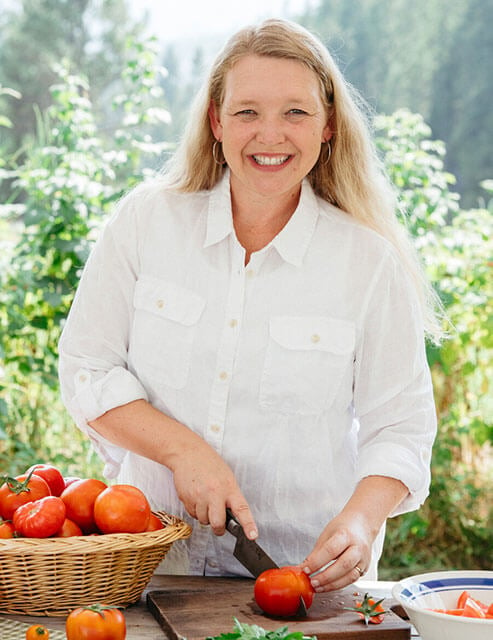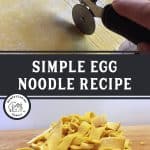
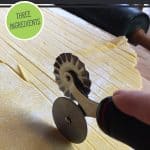
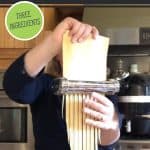

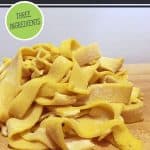

This homemade egg noodle recipe is the ultimate comfort food, easy to make and perfect for beef stroganoff, creamy leek pasta, topped with these easy creamed peas, or even as an alternative to rice for chicken dishes. You can dry the noodles for long-term storage and use them in this easy soup recipe, or even just cook the fresh noodles with butter for a simple side dish. The versatility and affordability of homemade egg noodles should make them a pantry staple for every homestead kitchen!

Table of Contents
ToggleWhy I Love Homemade Egg Noodles
During the spring and summer months, our egg-laying chickens really ramp up their production. That’s why we always do our best to preserve as many extra fresh eggs as possible during this time.
Homemade egg noodles are a great way to use up extra eggs and “preserve” them for later. Some of our other favorite methods of preserving eggs are:
Tips for the Best Homemade Egg Noodles
The perfect noodles don’t just make themselves. There are a few tips and tricks that help give your noodles the best consistency and turn out right each and every time:
- Make the Noodles Ahead of Time – Egg noodles aren’t the quickest recipe in the world to make, so if you’re going to make up a batch, you may as well make a very large batch! It’s a fun project to get the kids involved in and we like to make up a lot when our chickens are laying a lot of eggs.
- Learn to Read Your Dough – In my bread-making classes, I put a large emphasis on developing this skill. You can learn more about how to read your dough and other bread-making techniques in my free homemade bread video series.
- Allow the Dough to Rest – Resting your dough is important for gluten formation and a good end result for both texture and consistency. After you’ve mixed together the egg and flour, you’ll want to rest your dough for about 30 minutes before rolling and cutting them out. This will then allow you to roll it thin enough to cut into noodles. If you find the dough is springing back on itself, it hasn’t rested long enough.
- Pay Attention to Texture – The dough’s consistency is vital for perfect egg noodles. It should be smooth, elastic, and slightly tacky. If it’s too wet, add more flour. If too dry, add a bit of water until it’s right. If you face issues like sticky dough or uneven noodles, don’t worry. It’s part of the learning journey. Keep trying, and you’ll soon master making homemade egg noodles!
- Dough Thickness – Thickness is key! Aim for a uniform thickness of 1/16 to 1/8 inch. A rolling pin helps make the surface even.
- Cutting the Noodles – Use a sharp knife, a pizza cutter or this noodle cutter to cut uniform strips. The noodle cutting tool makes cutting faster and ensures noodles are the same size.
- Cooking the Noodles – Homemade egg noodles take much less time to cook than store-bought pasta. They usually cook in about 2-3 minutes but test a noodle after 2 minutes to make sure you don’t overcook them. The pasta should be nice and soft with a slight bite to it.
- Drying the Noodles – Lay your noodles on drying racks to air dry completely. This prevents them from sticking and improves their texture when cooked. You can alternately freeze noodles in individual bundles for quick cooking. Just dust the noodles well with flour before bundling them into a nest so the noodles don’t stick together.

Homemade Egg Noodle Variations
Basic homemade egg noodles are incredibly versatile, but sometimes it’s fun to customize a recipe to make it a little “extra.” Here are some ideas for homemade egg noodle variations:
- Herb-Infused Noodles – Add fresh or dried herbs, or if you have a freeze dryer, freeze dried herbs like parsley, basil, or thyme to the dough. Just chop them finely and mix them in for a fragrant twist.
- Spiced Noodles – Spices like turmeric, paprika, or garlic powder can add an extra kick. They bring vibrant colors and distinct flavors that can make any dish better.
- Whole-Wheat Noodles – Whole-wheat flour can add fiber, a nutty flavor, and a heartier texture. However, be aware that all-purpose flour is ideal for long-term storage because the refining process reduces the oils that go rancid over time.
- Gluten-Free Noodles – Quinoa, rice or chickpea flour are great substitutes if you need to make a gluten-free version. The measurements may vary, so learning to read your dough is key.
- Vegetable-Infused Noodles – Add pureed vegetables like spinach, beetroot, or pumpkin into the dough to add beautiful colors and extra nutrients.
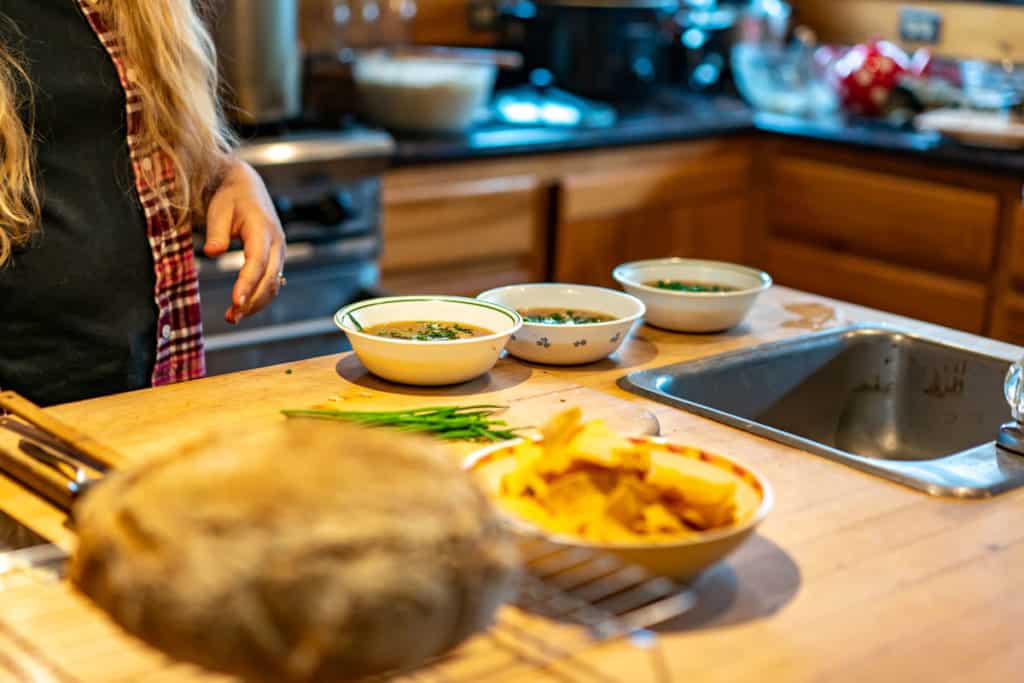
Ways to Use Homemade Egg Noodles
When you think of homemade egg noodles, the classic chicken or turkey noodle soup probably comes to mind. While we love homemade chicken noodle soup, there are so many more ways to incorporate noodles into your recipes:
| Dish | Ingredients | Cooking Method |
| Soups | Bone broth, vegetables, egg noodles | Boil broth, simmer ingredients, add noodles |
| Casseroles | Vegetables, sauce, cheese, egg noodles | Combine ingredients, bake until bubbly |
| Garden Stir-Fry | Vegetables, protein, sauces, egg noodles | Stir-fry ingredients quickly, toss with cooked noodles |
| Versatile Side Dish | Beef, Pork, Spatchcock Turkey, Garlic Chicken, Roasted Chicken with a Lemon Reduction, Meatloaf, or seafood, vegetables, and egg noodles | Cook proteins and vegetables, and serve with buttered noodles |
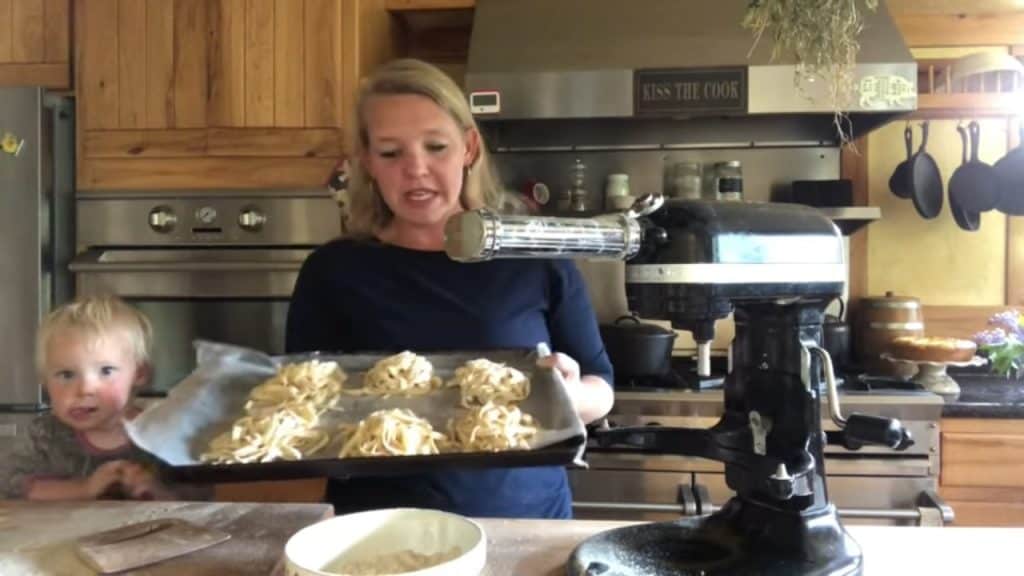
Storing Egg Noodles for Later
There are multiple ways to store your egg noodles. One of the easiest ways is to bundle your noodles into little “nests” and flash-freeze them on a cookie sheet lined with parchment paper.
Once the bundles are frozen, you can store them in a large zip-top baggie for quick individual servings of pasta.
Alternatively, you can dry your noodles completely in bundles (be sure the inside of the bundle is completely dry before storing them). You can use a pasta drying rack or dry your noodles lying flat on a cooling rack.
If noodles are dried in bundles, simply store them in a large glass container or a zip-top bag. Noodles dried with a pasta rack are a bit harder to package (see the video for an example).

How Many Egg Noodles Should I Make for Long-Term Storage?
Determining how many egg noodles you’ll want to make for your family will vary for each household. To figure this out, ask yourself how many pounds of pasta your family eats in a week (how many packages of pasta do you buy at the grocery store)?
Then, multiply this out for 6 months, and that’s how many egg noodles you should make.
Keep in mind that you’ll want to weigh your egg noodles AFTER they’re completely dry, as they’ll continue to lose water weight.
See how many pounds your batch of egg noodles makes, and you’ll have your number!
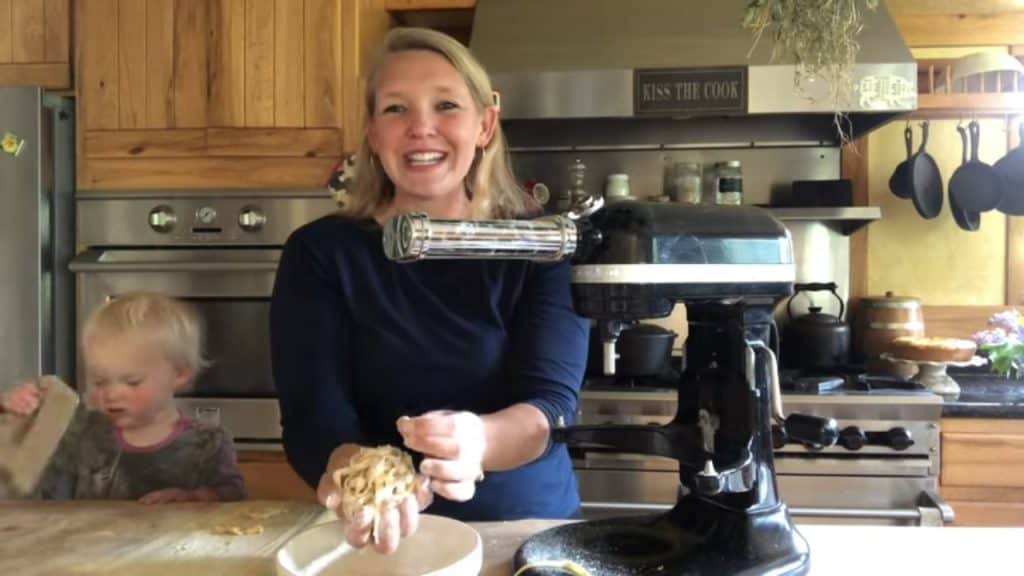
How to Make Homemade Egg Noodles
Supplies Needed
- Mixing Bowl – The size of your bowl will depend on whether you scale this recipe up or down. If using the standard measurements listed, a 4-quart bowl works well.
- Whisk – If you don’t have a whisk, you can use a fork.
- Wooden Spoon – I love these wooden spoons from Riverwood Trading, but if you don’t have a wooden spoon, you can use a silicone spatula or a fork.
- Tea Towel – A damp tea towel keeps the dough ball from drying out while resting.
- Dough Roller – If you don’t have a special dough roller, a simple rolling pin and pastry cutter (or pizza cutter or knife) will do. During the rolling-out steps, follow the same instructions; just roll out on a flour-dusted surface.

Ingredients Needed
Would you believe that delicious homemade egg noodles can be made with just three ingredients?
- Flour – I like to use all-purpose flour for this recipe. Because we’re going to be storing them long-term, I don’t want to use something like whole grain that might decrease the shelf-life.
- Eggs – This is a fantastic way to use up excess eggs.
- Salt – Don’t forget to salt your dough! If you’ve ever tasted bread or pasta that hasn’t been properly seasoned with salt, you’ll know this is an important ingredient.
And water, but does that even count as an ingredient?
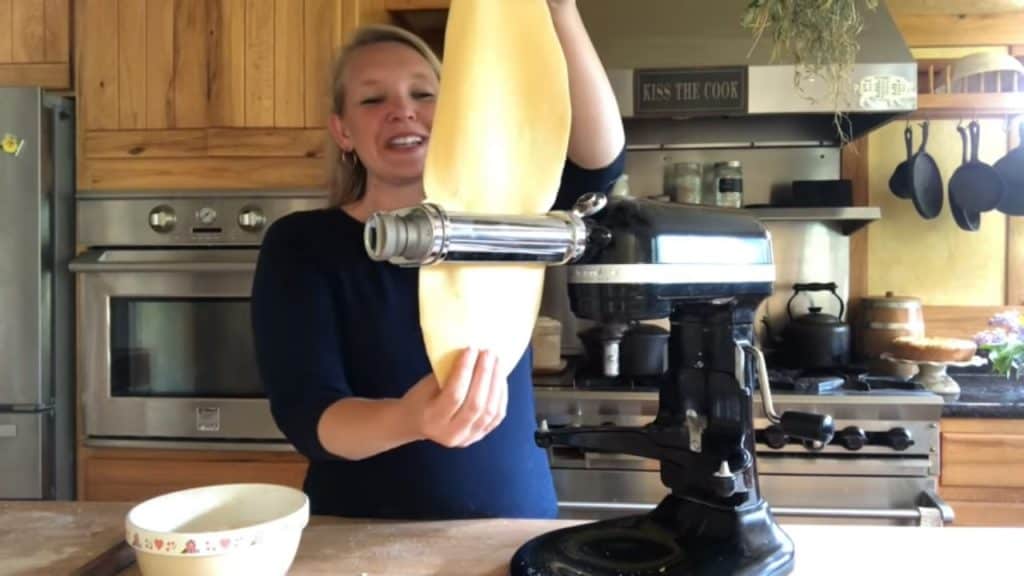
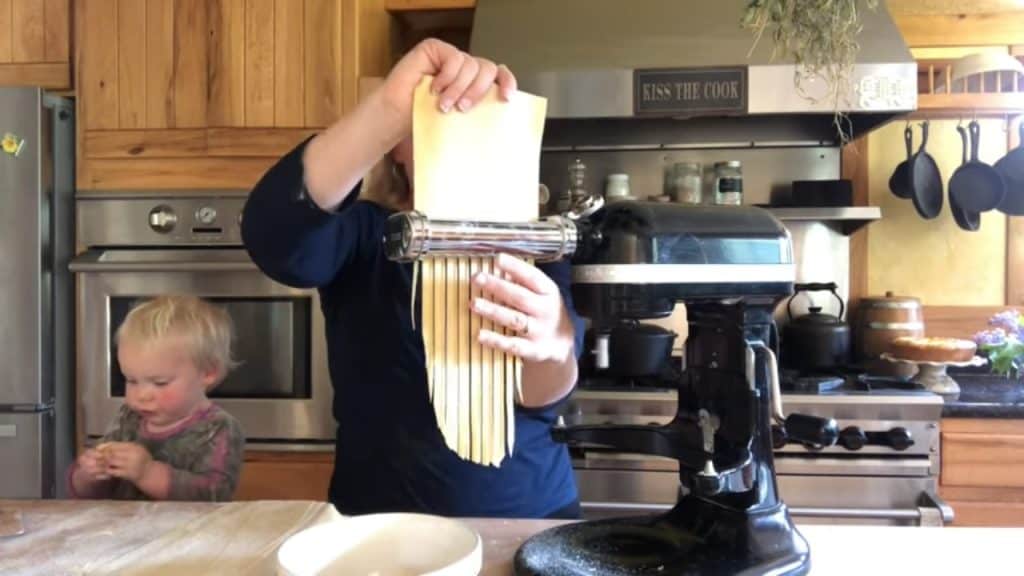

Step-by-Step Directions
These homemade noodles are very simple, but they do take some time. Once you get the hang of this recipe, you can create batch after batch and have noodles prepared for the whole year!
- Create a mound of your flour and salt in a bowl. Whisk together and create a well in the middle of your flour.
- Add in a couple of eggs to start, stirring them into the flour with a fork or wooden spoon.
- Add in another whole egg, constantly stirring. Add another egg yolk, if needed, and stir some more.
- Once your dough starts coming together in a ball, you’ll want to add some water, one tablespoon at a time. Homestead Hack: Remember to read your dough, as everyone’s climate is a little bit different.
- Once all the flour is incorporated into the dough, you’ll want to knead the dough on a lightly floured work surface for 5-10 minutes (5 minutes in the stand mixer, about 10 minutes by hand) until dough is smooth and elastic.
- Let your dough rest for 30 minutes. If you’ll be working with your dough within an hour or so, wrap it in a damp tea towel and let rest at room temperature. If you won’t be making the noodles for a few hours or more, wrap your dough in plastic wrap and put it in the refrigerator to rest for a couple of hours, up to a full day.
- When you’re ready to move on, roll the dough into a flat disc. Cut the dough in half and form a long oval shape.
- Using your pasta roller on the widest setting, roll your dough through two times.
- Dust each side of the sheet of pasta with flour between each setting.
- Reduce the size setting on your pasta roller and continue rolling your pasta sheet through, two times on each setting, until you get the desired thickness of your noodle. Homesteading Hack: If your sheet of pasta gets too long to work with, simply cut it in half and continue. I don’t recommend going too thin. In my experience, this causes the noodles to tear or be extremely difficult to work with. On my pasta roller, this means I get down to the 5 setting.
- Once your sheet of pasta is at the desired thickness, be sure to dust with flour again to avoid having the noodles stick together on the next step.
- Switch your machine to the pasta cutter (I like to use a nice wide cut, like a fettuccini size) and cut each sheet into pasta. Toss the pasta in a bowl of flour and gently tap off any excess flour. If they’re too long for your liking, you can cut the noodles in half to make them shorter.
- Bundle your noodles into a little nest and place them on a parchment or wax paper-lined cookie sheet.
- Allow the fresh egg noodles to dry in bundles for 1-2 days until they are completely dry and break easily when bent.
- To cook, drop bundles into a pot of boiling water that’s been liberally salted and cook for 2-3 minutes (or preferred doneness).
Fresh pasta stores best for up to 6 months. My suggestion would be to store them in a white (not clear) food-grade bucket with an air-tight gamma seal lid.
Did you make this recipe for homemade egg noodles? If so, please leave a star rating in the recipe card below. Then, snap a photo and tag us on social media @homesteadingfamily so we can see!

FAQ
You’ll need flour, fresh eggs, and a pinch of salt.
Yes, you can! Use a wine bottle or another object to roll the dough evenly.
Roll the dough on a floured surface using a rolling pin. A pasta machine or dough roller helps achieve uniform thickness.
It’s recommended but not necessary. You can cook fresh egg noodles right away, but drying them for 1-2 hours improves their texture when cooked.
Yes, they’re great in soups. They soak up flavors and add richness.
Making your own is usually cheaper. Flour and eggs are affordable, and you get more. Plus, you control the quality and freshness.
You’ll need a mixing bowl, a rolling pin or alternative, and a knife or pizza cutter. Drying racks or a clean surface are also necessary. A stand mixer helps with kneading but isn’t required.
Yes, you can! Adding herbs and spices gives your noodles unique flavors. Try some of the other flavor variations suggested in this tutorial.
Over-kneading the dough will cause excessive gluten development, creating tough noodles. Follow more tips in this tutorial to create perfectly tender noodles.
Knead for just 5-10 minutes until the dough is smooth and elastic.
Store them in an airtight container at room temperature for a few days. For longer storage, refrigerate or freeze them.
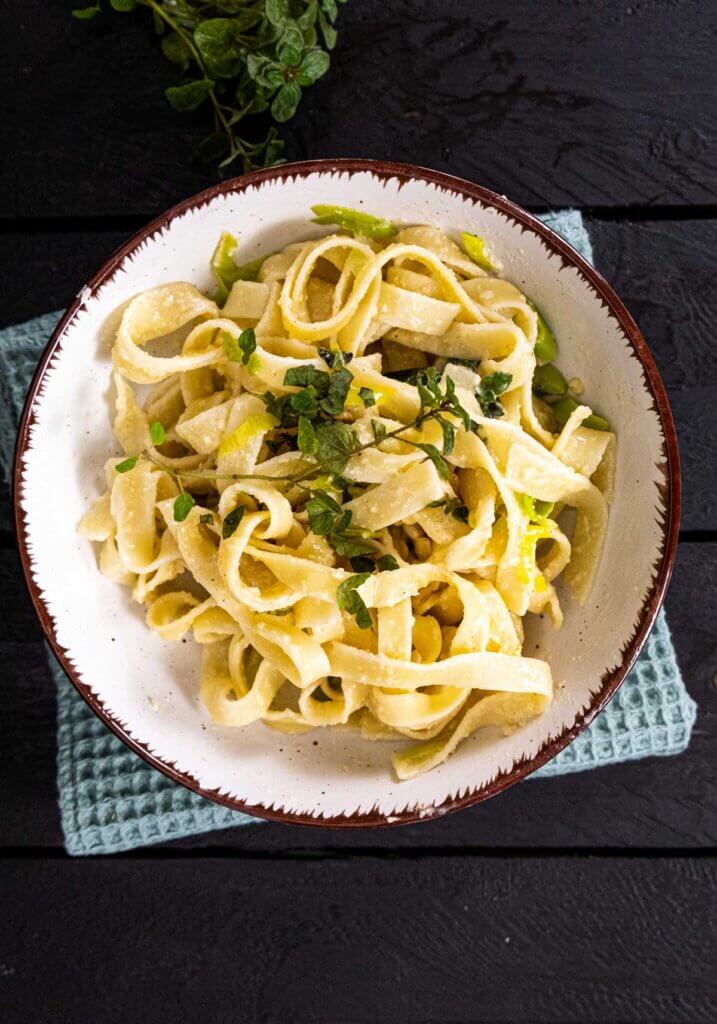
Other Posts You May Enjoy
- Creamy Leek Pasta
- Instant Pot Chicken Bone Broth (That Gels Every Time)
- Easy Soup Recipe
- Instant Pot Boiled Eggs | Perfect Hard Boiled Eggs Every Time
- Water-Glassing Eggs
- Freeze Drying Eggs
- Pickling Eggs

Homemade Egg Noodles
Ingredients
- 2 cups flour (I used all-purpose flour)
- 1/4 tsp sea salt
- 3 whole eggs
- 1 egg yolk
- 2-3 Tbs water (add 1 Tbs at a time, as needed)
Instructions
- Add flour and salt to a bowl, whisk to combine then create a "well" in the middle of your flour.
- Add two whole eggs and stir them into the flour with a fork or a wooden spoon.
- Add in another whole egg, constantly stirring.
- Add another egg yolk, if needed, and stir some more.
- Once your dough starts coming together add water, one tablespoon at a time. (Remember to read your dough!)
- Once all the flour is incorporated into the dough, knead for 5-10 minutes (5 minutes in the stand mixer, about 10 minutes by hand) until dough is smooth and elastic.
- Let your dough rest for 30-60 minutes.
- Roll out the dough into a flat disc.
- Cut the dough in half and form a long oval shape.
- Using your pasta roller on the widest setting, roll your dough through two times.
- Dust each side of the sheet of pasta with flour between each setting.
- Reduce the size on your pasta roller and continue rolling your pasta sheet through, two times on each setting, until you get the desired thickness of your noodle.
- If your sheet of pasta gets too long to work with, simply cut it in half and continue.
- Once your sheet of pasta is at the desired thickness, dust with flour again to avoid having the noodles stick together on the next step.
- Switch your machine to the pasta cutter and cut each sheet into pasta.
- Toss the pasta in a bowl of flour and gently tap off any excess flour.
- Bundle your noodles into a little nest and place on a parchment or wax paper-lined cookie sheet.
- Allow pasta to dry in bundles for 1-2 days until they are completely dry and break easily when bent.
- To cook, drop bundles into salted boiling water and cook for 2-3 minutes (or preferred doneness).
Notes
- Depending on your flour and the climate of your kitchen, you’ll need to adjust both the egg quantity and water quantity to obtain the right consistency. (See video for reference).
- When resting your dough, if you’ll be working with it within an hour or so, wrap it in a damp tea towel and let rest at room temperature.
- If you won’t be making the noodles for a few hours or more, wrap your dough in plastic wrap and put it in the refrigerator to rest for a couple of hours, up to a full day.
- I don’t recommend going too thin on your pasta roller settings. In my experience this causes the noodles to tear or be extremely difficult to work with. On my pasta roller, this means I get down to the 5 setting.
- Fresh pasta stores best for up to 6 months. My suggestion would be to store them in a white (not clear) food-grade bucket with an air-tight gamma seal lid.









